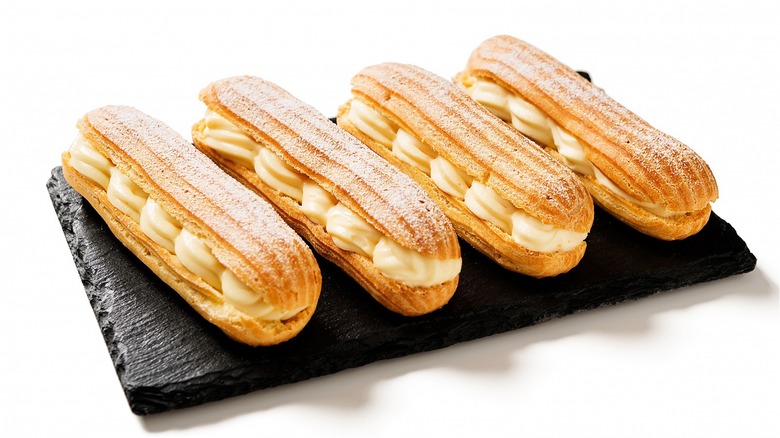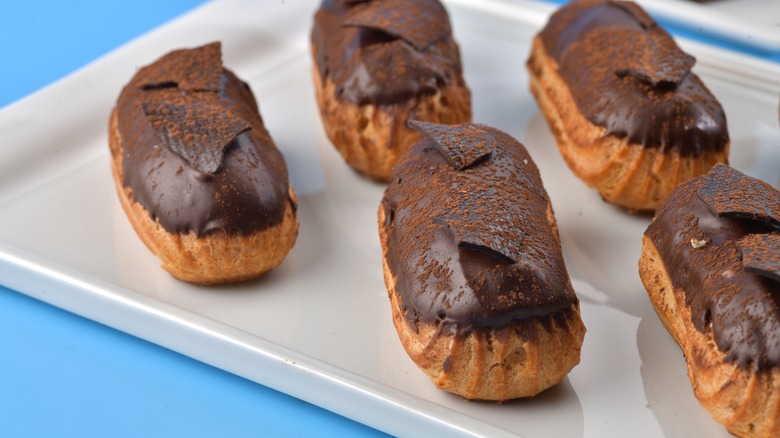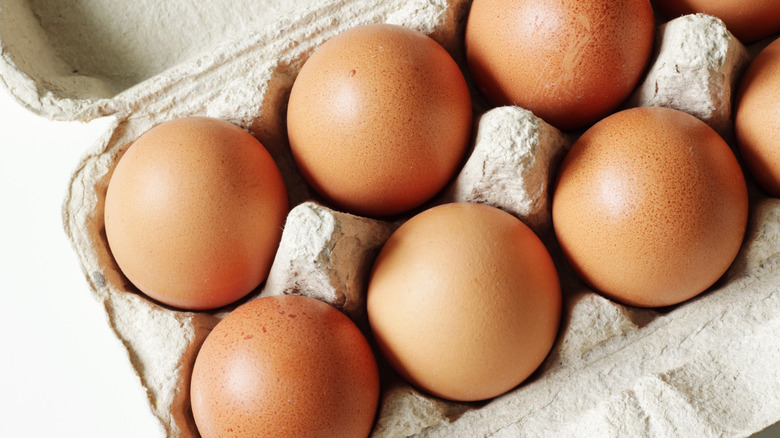The Biggest Mistake You're Making With éclairs Lies In The Eggs
Éclairs make a creamy, decadent addition to any dessert lineup, and many U.S. bakeries carry this French treat. Buying them in a bakery saves time and energy, but homemade éclairs can taste even more delicious than their store-bought counterparts when made correctly. It all comes down to the eggs. Your classic éclair recipe sandwiches a creamy custard between two long pieces of choux dough, then tops the pastry with a layer of chocolate. The topping and filling can change depending on the éclair. However, the choux dough is a necessary component of this dessert. The success of homemade éclairs is contingent on getting it right, as choux dough depends on egg protein to rise.
Choux dough leavens with steam instead of using baking soda, baking powder, or even yeast. The trapped air and water cause the egg protein to expand, enabling the dough to rise. This sets choux dough apart from pastry dough, giving it the lighter texture seen in treats like cream puffs and gougères. Using too little or too much egg in your éclairs can ruin the entire batch.
Éclairs with too little egg in the batter will come out dense and over-inflated. Meanwhile, too much egg will create a flattened dough that won't hold the éclair together well. Needless to say, the eggs are the most important part of the process. For the perfect éclair, the end result should be a dough that's moderately risen and hollowed out completely.
How to get the perfect éclair texture
To get the texture of your éclairs just right, you'll need to be conscious of how much egg you're using in the dough and how you mix it into the batter. Typically, éclair recipes call for the following ingredients: butter, salt, milk, water, flour, and sometimes sugar. Once these components have reached a boil and thickened appropriately, you must allow them to cool so that you don't cook the eggs when you add them, which would cause them to curdle and spoil the dough.
Whisking in the eggs is the final step of mixing the dough. Froth the eggs slightly before adding them, and it's advisable to pour them slowly into the batter. Once you've added about half of the whisked eggs, you can check to see how you're doing. The right consistency will see your batter coming off a spatula slowly, with a texture that's not too thin or thick. If the batter is too thin, it'll quickly run off the spatula in thin rivulets. Meanwhile, a too-dense batter will stay on the spatula or fall off in large, doughy wads.
What to do if you've messed up the eggs
If the consistency of your éclair dough is ideal, you can move forward with baking your pastries. However, overly thin and too-thick batter require tweaking before advancing to the next step. If your batter is too thin, you've added too much egg. Checking consistency early can prevent this from happening, but sometimes, you won't notice until it's too late. This can be harder to rectify. However, some bakers recommend making a little extra batter and putting it aside before mixing in the eggs. This way, you can slowly add this additional batter to your watery one until it hits the right density.
Thick dough is easier to fix, as it merely requires adding more whisked eggs. If you've caught this problem early enough, you should still have additional egg mixture to pour in. You'll want to continue doing so carefully, stopping as soon as your batter hits the right consistency. Once the dough is mixed, the hardest part of making éclairs is over. Adding the cream filling is a cakewalk compared to forming the dough, and the cream will fit into the hollow pastry well after the work you've put into ensuring its proper shape.


